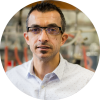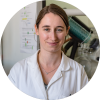A 'Lego'-like method to access multifunctional hydrogels for mesenchymal stem cell-based cartilage repair

Funding: ANR-16-CE18-0003-01
October 2016- September 2019

The LEGOGEL multidisciplinary project combines peptide chemistry and sol-gel inorganic polymerization to provide multifunctional hydrogels for full-thickness cartilage lesion repair using mesenchymal stem cells (MSC).
Treatment of cartilage injuries remains one of the most difficult challenges in regenerative medicine. Mesenchymal stem cell (MSC)-based therapies represent one possible innovative strategy. It is highly important that MSC will be associated with a support, to put the cells directly into the lesion to be repaired but also to avoid dissemination at the time of implantation. The support can be a scaffold shaped to fit the cartilage defect or a liquid that can be injected and can rapidly turn into a gel to fill the lesion. LEGOGEL is a multidisciplinary project aiming at designing cell therapy strategies for osteo-articular diseases.
Legogel Project
LEGOGEL aims at establishing a ground-breaking method to build modular and multifunctional hydrogels whose synthesis was too complex to be envisioned by existing methods. LEGOGEL relies on original ‘hybrid’ bioorganic-inorganic building blocks (peptides, biopolymers, dyes…) bearing alcoxysilane groups. Hydrolysis and condensation of these groups lead to the formation of a covalent hydrogel network. Interestingly, this sol-gel process occurs in water in physiological conditions, without the use of chemical cross-linkers, toxic reagents or catalysts. It is thus compatible with biomolecules (ligands, growth factors…) and the presence of cells. Moreover, the mixture of blocks is first obtained as a colloidal solution that can be either injected, or 3D-printed before complete gelation to get porous scaffolds. Taking advantage of this innovative ‘lego-like’ bottom-up approach, the complexity of extracellular matrices (ECM) composed of a huge variety of biological components, could be mimicked. Any type of bioactive peptide, biopolymer, dye or contrast agent can be combined in appropriate ratio to yield covalent hydrogel. Of course, any other component (as growth factors) can be added during the gel formation, in a non-covalent way.
Specific objectives of LEGOGEL project
- The first goal will be the synthesis of the different hybrid blocks (i.e. the ‘lego parts’). Bioactive peptide promoting cell migration and colonization, biopolymers (growth factors) and contrast agents will be specifically silylated. The synthesis of hybrid bioactive peptides is already mastered by the partners but the introduction of silyl groups on proteins is a challenge that will be tackled.
- The second objective will be to obtain multifunctional hydrogels whose biological and physicochemical properties (stiffness, porosity, degradability…) will be suitable for cell-based engineering. The obtainment of hydrogel substrates from liquid solution will be studied. The most challenging work will be the control of gelation conditions to transfer the soft polymerization method on the 3D printer for the biofabrication of cell-seeded porous scaffolds. If required, Peptide sequences sensitives to ECM degradation enzymes will be incorporated to tune the degradation rate of the matrix and to release the differentiation factors to induce the lineage commitment.

3D printer used for the project - The third objective will be to obtain optimized hydrogel substrates promoting in vitro and in vivo MSC colonization and differentiation into chondrocytes or osteoblasts. Different composition of hydrogels, containing differentiation factors tailored to mimic specific cartilage and subchondral bone environments will be assayed to obtain the ‘ideal’ substrate. It will be either 3D-printed as a scaffold or used as an injectable hydrogel. Ultimately, the scaffold will present a bilayer membrane composed of TGFβ3- hyaluronic acid upper layer to induce differentiation of MSCs into chondrocytes and secretion of the cartilage ECM; and BMP2-hydroxyapatite-collagen lower layer to favor the differentiation of MSC into osteoblasts.








